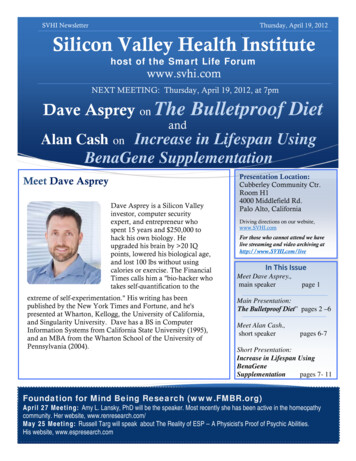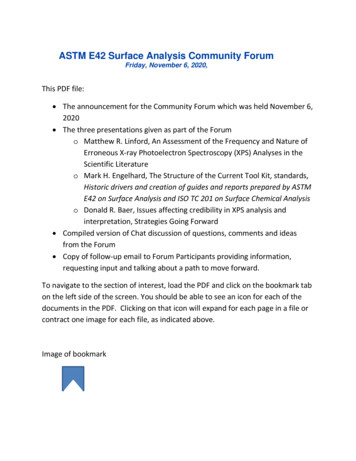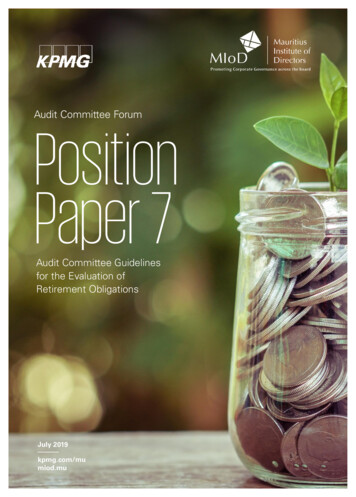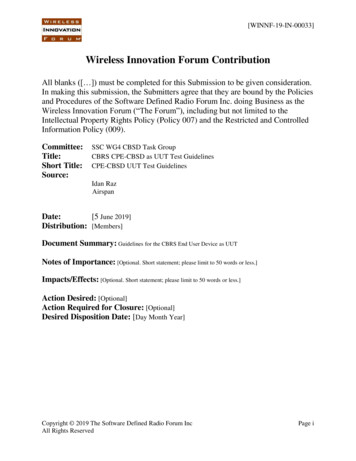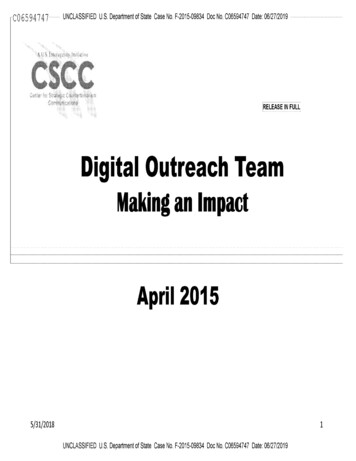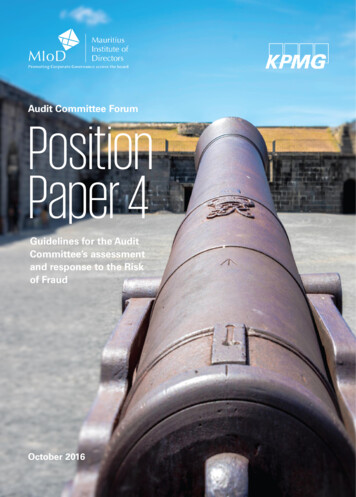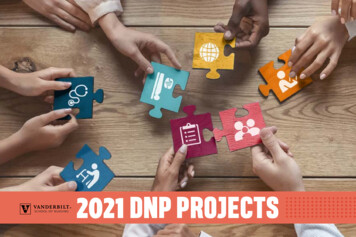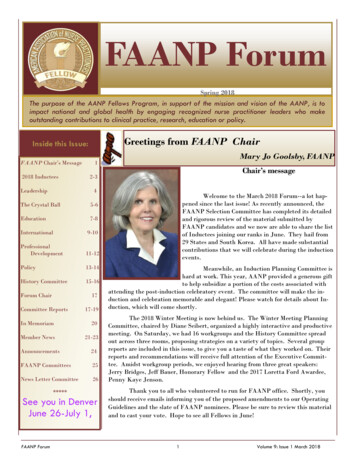
Transcription
FAANP ForumSpring 2018The purpose of the AANP Fellows Program, in support of the mission and vision of the AANP, is toimpact national and global health by engaging recognized nurse practitioner leaders who makeoutstanding contributions to clinical practice, research, education or policy.Greetings from FAANP ChairInside this Issue:FAANP Chair’s Message2018 InducteesLeadershipMary Jo Goolsby, FAANP1Chair’s message2-34The Crystal velopment11-12Policy13-14History Committee15-16Forum Chair17Committee Reports17-19Welcome to the March 2018 Forum--a lot happened since the last issue! As recently announced, theFAANP Selection Committee has completed its detailedand rigorous review of the material submitted byFAANP candidates and we now are able to share the listof Inductees joining our ranks in June. They hail from29 States and South Korea. All have made substantialcontributions that we will celebrate during the inductionevents.Meanwhile, an Induction Planning Committee ishard at work. This year, AANP provided a generous giftto help subsidize a portion of the costs associated withattending the post-induction celebratory event. The committee will make the induction and celebration memorable and elegant! Please watch for details about Induction, which will come shortly.Announcements24FAANP Committees25News Letter Committee26The 2018 Winter Meeting is now behind us. The Winter Meeting PlanningCommittee, chaired by Diane Seibert, organized a highly interactive and productivemeeting. On Saturday, we had 16 workgroups and the History Committee spreadout across three rooms, proposing strategies on a variety of topics. Several groupreports are included in this issue, to give you a taste of what they worked on. Theirreports and recommendations will receive full attention of the Executive Committee. Amidst workgroup periods, we enjoyed hearing from three great speakers:Jerry Bridges, Jeff Bauer, Honorary Fellow and the 2017 Loretta Ford Awardee,Penny Kaye Jenson.See you in DenverJune 26-July 1,Thank you to all who volunteered to run for FAANP office. Shortly, youshould receive emails informing you of the proposed amendments to our OperatingGuidelines and the slate of FAANP nominees. Please be sure to review this materialand to cast your vote. Hope to see all Fellows in June!In Memoriam20Member News21-23*****FAANP Forum1Volume 9: Issue 1 March 2018
Congratulations2018 FAANP INDUCTEESThe Fellows of the American Association of Nurse Practitioners (FAANP) announce with pride the 2018 Fellows.The 2018 FAANP Induction Ceremony will be held during the AANP National Conference in Denver, CO, andwill take place the evening of Thursday, June 28, 2018.InducteeCity and StateInducteeCity and StateAmita AvadhaniKendall Park, NJKate GawlikColumbus, OHTina BettinMarion, WISafiya George DalmidaTuscaloosa, ALKimberly Broughton-MillerGeorgetown, INWanda Gibson-ScipioDetroit, MILinda BrownHialeah, Fl.Patricia GivenStaten Island, NYHelen BrownDavidsonville, MDBrian CoodroadSt. Paul, MNTheresa BrownThousand Oaks, CADeborah GrayVirginia Beach, MDKathleen BurkhartEdison, NJDonna GulletteLittle Rock, ARTerri CavalierePlainview, NYMary Jane HansonLehighton, PAMary Jo CerepaniMcKees Rocks, PASurani Hayre-KwanSanta Rosa, CAJill CochranLewisberg, WVMeredith HeydeSimpsonville, SCPatricia DalyTucson, AZDeborah HoplaFlorence, SCPamela DaviesSeattle, WAAnnette Jakubisin-Konicki Putnam, CTMelissa DavisMesa, AZJennifer KimBrentwood, TNSharon Dudley-BrownAberdeen, MDTay KopanosLummi Island, WANancy EdwardsWest Lafayette, INBeverly LangMarriottsville, MDKristie FlammOro Valley, AZRobin LawsonTuscaloosa, ALFAANP Forum2Volume 9: Issue 1 March 2018
Congratulations2018 FAANP INDUCTEESThe Fellows of the American Association of Nurse Practitioners (FAANP) announce with pride the 2018 Fellows.The 2018 FAANP Induction Ceremony will be held during the AANP National Conference in Denver, CO, andwill take place the evening of Thursday, June 28, 2018.InducteeCity and StateInducteeCity and StateAlicia LaPardGillette, WYLisa RobertsRedlands, CADenise LucasWeirton, WVKelly RosenbergerRockford, ILPaula McCauleyManchester, CTGretchen SchumacherGrand Rapids, MITeena McGuinnessBirmingham, ALLaura SearcySmyrna, GASusan MullaneyNeedham, MAElizabeth SloandBaltimore, MDJulianne OssegeBrighton, KYMary SmaniaDewitt, MIJessica PeckFriendswood, TXMary SmithStarkville, MSDanielle PendergrassPrice, UTRhayun SongDaejeon, S. KoreaGeorge Peraza-SmithTampa, FlCharlotte ThrallPhoenix, AZNicholas PerrinoNew York, NYColleen Walsh-IrwinEast Northport, NYEdward PoindesterElkridge, MDLinda WatkinsMadison, MSLouise ReaganVernon, CTGeorgann WeissmanPalm Beach Gardens, FLElizabeth RendeBahama, NCKaren WhittCrozet, VAImelda ReyesAtlanta, GAMelosdy WilkinsonFairfax, WAKathleen RhodesHarvest, ALMegan WilliamsMilford, DEAmy RobertsAthens, TXEdward YackelSan Antonio, TXFAANP Forum3Volume 9: Issue 1 March 2018
LeadershipMary Jo Goolsby, FAANPDear Fellow: When Did You Become a Leader?I’ve been reading two of Daniel Pink’s books: Drive: The SurprisingTruth About What Motivates Us (2009) and When: The Scientific Secrets of PerfectTiming (2018). As I thought about what drives us and the concept of timing,this title question arose regarding when leadership emerges. I’ve long held thebelief that leadership can emerge at any career stage and grows with time. Andwhile one might be a leader among their work-team as they go about their day-to-day routines, there is some “special sauce” that triggers a person to have theconfidence raise their hand and then step out into the traffic to begin a morepublic path to leadership. So, what was that for you?Why is this important? you might ask (rather than Why am I reading twobooks at one time?). Each AANP Fellow has a well-established history of contributions to the NP role and demonstration of leadership. Our reflection andawareness regarding when we each became leaders and what influenced thatemergence of leadership is important as we encourage growth in others. It’s notsomething I can immediately answer and wonder how easy it will be for each ofyou. Regardless, stories such as these can serve as illustrative, inspirational narratives.Discussing what drives people, Pink describes why external rewards areless motivating for individuals he calls “Type I’s”, whose behavior leads tostronger performance and well-being. Type I’s are “made”, not born—made aswe seek autonomy, mastery, and purpose. In When, Pink discusses the science behind the start, mid-points, and ends of arange of events including naps, school days, projects, and careers. It was the following, included in the final chapter discussing time as it relates to tense, that triggered my question and prompted this column:Taken together, all of these studies suggest that the path to a life of meaning and significance isn’t to ‘live in the present’ asso many spiritual gurus have advised. It is to integrate our perspectives on time into a coherent whole, one that helps uscomprehend who we are and why we’re here. . . The challenge of the human condition is to bring the past, present, and future together. p. 217.So, we are repeatedly told that stories are important. For example, the FAANP History Committee has interest inrecording the Fellows’ stories for posterity. Our policy experts encourage us to use stories when advocating for health policy.And we should use stories to inspire the current and future generations of NP leaders.My expectation is that few of us will have an immediate or final answer to the question of when we became a leader. I know Iwill have to turn off devices and find some quiet time to do it justice. Meanwhile, I hope that the question will trigger someenjoyable and nostalgic reflection on what and how you were started down the path that led you to our Fellowship—andwhen that happened. I further hope that you will use this heightened awareness as you inspire others!ReferencesPink, D. (2018). When: The scientific secrets of perfect timing. New York: Riverhead Books.Pink, D. (2009). Drive: The surprising truth about what motivates us. New York: Riverhead Books.FAANP Forum4Volume 9: Issue 1 March 2018
The Crystal BallJeffrey C. Bauer, Ph.D., FAANP (Honorary Fellow)“Stewardship as a Professional Opportunity for Nurse Practitioners”I’ve given over a thousand keynote speeches about the future ofhealth care since the 1970s. Program planners have always expected me togaze into my crystal ball through the filters of cost, quality, and access—theconstant goals of health reform across these five decades. Until now, I’venever been explicitly asked to deliver a keynote focused instead on stewardship, the central theme of the 2018 Annual Meeting of the AANP Fellowsheld in New Orleans on February 24 and 25.“stewardship: the conducting, supervising, ormanaging of something; the careful andresponsible management of resourcesentrusted to one’s care; protecting and beingresponsible .” (Merriam-Webster Dictionary)Forecasting the future from the perspective of stewardship may seem like a flimsy foundationfor my regular FAANP Forum column. Doesn’t stewardship mean cutting costs, improving quality, andexpanding access? Isn’t stewardship just a new word to describe the same old goals of health reform? Ithink not. The distinction is sufficiently important that stewardship should be separately addressed byanyone seeking to improve our population’s health. Therefore, NP Fellows deserve recognition for building an entire conference around stewardship and how its principles should shape the evolution of theirprofession’s role in allocating resources responsibly.My analysis begins by highlighting a dramatic shift in resources available for health care and forcesthat dictate their flow through the medical marketplace. Until recently, the health sector of the Americaneconomy grew every year, from 4.5% of gross domestic product when Medicare and Medicaid were createdin 1965 to almost 18% of GDP just five years ago. No other economic sector grew as consistently andsubstantially. Governments and employers financed between 80% and 85% of total spending throughoutthis period, leaving health plans to determine how the money would be distributed. Periodic efforts athealth reform focused almost exclusively on reducing the increase in spending; none of the resulting laws orregulations succeeded. (In fairness to providers, most have known for some time how the delivery systemshould be transformed, but few have made the changes because health insurance wouldn’t pay for them.)As a medical economist, I believe the medical marketplace began to shrink two to three years ago notbecause of reform, but because governments and employers finally reached the limits of what they werewilling and able to spend on health care—especially when they finally realized that the US was spendingalmost twice as much on health care as 35 other industrialized countries that all had healthier populations.Political leaders and corporate executives also decided that consumers must have “skin in the game.”In other words, any overall increase in medical spending must henceforth come from consumers. Giventhat 90% of all Americans are no better off economically today than they were ten years ago (all netgrowth in income since the 2008 great recession has gone to 10% of the population!), you don’t needa PhD in economics to understand why health spending has dropped to 17% of GDP after growing for50 years. The vast majority of Americans have less money to pay for health care.FAANP Forum5Volume 9: Issue 1 March 2018
The Crystal BallJeffrey C. Bauer, Ph.D., FAANP (Honorary Fellow)From the perspective of economics, money for health care has become a scarce resource. Patients can nolonger rely on Medicaid and Medicare or employer-sponsored health plans to cover rising costs of care, nor dothey have sufficient disposable income to make up the difference. To add insult to injury, consumers generallydon’t have the expertise to know what health services to purchase, a decision made for them by a doctor whenhealth insurance paid the bill. Therefore, consumers need a steward, someone with the professional knowledgeto help them negotiate the evolving health system wisely and responsibly. Which health professionals could fillthis role? I cannot imagine any group better qualified than nurse practitioners.NPs will encounter strong resistance if they take on this new role. Stewardship directly challenges thelong-standing assumption that health professionals do the right things in spite of distortions created by ourunique approach to reimbursement. Stewardship compels us to step back and see if providers really are doingthe right things, given a patient’s concepts of health and financial limitations. It requires caregivers to helpeliminate unnecessary care and reallocate wasted resources to productive use. My good French friend, Dr. JeanPierre Thierry, addresses this problem compellingly in his latest book, Trop Soigner Rend Malade (Too MuchCare Makes You Sick). We need a comparable book in English to help embed stewardship in the Americanhealth care system.Stewardship will need to be based on ethical protocols for helping consumers ask and answer difficultquestions, such as: Do I really need this specific service now? Is there a less-expensive intervention that I cantry instead? Can the decision wait until we see how my condition progresses? Who will be responsible for following and sequencing my care? Do potential benefits outweigh potential risks? What are the side-effects? Do Iwant to put up with the side-effects, even if I can afford the treatment? What is the success rate? From myperspective, is the treatment worse than the disease? (Choosing Wisely provides good resources for developingthis dimension of stewardship.)Stewardship will often cause patients to make decisions that contradict caregivers’ professional recommendations, as shown by the significant number of men who would not have undergone doctor-recommendedcare for prostate cancer, or women who would not have followed doctors’ orders for breast cancer treatment, ifthey had understood all the risks and costs involved. The resulting conflict between informed consumers andhealth professionals will require corresponding reform of malpractice laws.Above all, stewardship must change the way we manage health reform. Contrary to the conventionalwisdom that reforms should cut costs, improve quality, and extend health insurance to more people, stewardship challenges us to confront the paradox that delivering less-expensive and higher-quality care to more peopleis a waste of money if patients’ overall well-being is not improved in the process. Health professionals are notbeing good stewards if they cause patients to consume services they don’t need, shouldn’t have, or don’t want—even if the care is inexpensive and safely delivered. Establishing stewardship as a specific goal of health reformwill help resolve the paradox. Nurse practitioners have an excellent opportunity to lead this essential transformation because no other health profession has yet established stewardship as a core professional competency.AUTHOR: Jeff Bauer, PhD, FAANP(H), is an internationallyrecognized, independent health futurist and medical economist withnearly 50 years in health care. He has published over 250 works thatfocus on ways to improve the medical marketplace. He can be contacted at jeffreycbauer@gmail.com or (970) 396-3280, orwww.jeffbauerphd.comFAANP Forum6Volume 9: Issue 1 March 2018
EducationJamie Newland, FAANPCompetency-Based EducationThere is a paradigm shift in how to educate and evaluatelearners. Learners are not only students but also include health careprofessionals in practice; learning and skill development occurs fromthe beginning of one’s educational program through to retirementalong a continuum. According to the Macy Foundation (2017) report,“Learners are successful when they transition through different stages and different practice environments based not on their performance on an exam after spending a specific time in formal education,but on their ability to demonstrate measurable competence in therequisite set of behaviors needed to succeed at the next level or stageof performance” (p. 5). The speed with which a learner progresses isbased on mastery of identified competencies that are measureable.Conference attendees (8 of 38 were nurses) met in June 2017 came toa consensus and made the following five recommendations to movetoward a “competency-based, time-variable educational model” forall health professions across the continuum of their careers, posthaste. The explanation for Recommendation I is listed.I: System RedesignCurricula, learning environments, and faculty development require systematic redesign toachieve a successful competency-based, time-variable health professions education system. (MacyFoundation, 2017, p. 11)II: Creating a Continuum of education, training, and practiceIII: Implement a Robust Program of AssessmentIV: Enabling TechnologiesV: Outcomes EvaluationBased on these recommendations, the American Association of Colleges of Nursing (AACN) conveneda special APRN Competency-Based Education for Doctoral-Prepared APRNs Work Group. Participantsfrom 25 nursing organizations representing education, licensure, certification, and accreditation. The groupidentified common competencies for doctoral-prepared advanced practice registered nurses foundational to allfour roles. The competencies “are not intended to replicate previously identified competencies for advancedpractice, but rather to demonstrate the utility of a consistent framework that fosters both intraprofessionaland interprofessional communication” (2017, p. 2). Eight domains were identified; there are 3-6 competenciesin each domain; examples of a competency in two domains are listed. Competencies are observable by thelearner, faculty, and preceptors; realistic, and measureable by progression indicators at Time 1 (beginning ofstudent’s clinical experiences) and Time 2 (completion of APRN student’s doctoral education or graduation).Domain 1: Patient CareCompetency1) Performs a comprehensive,evidence-based assessment.Time 1Performs a focused- assessment ofa patient with only 1-2 presentingproblems, using a template andunder mentored guidance.Time 2Demonstrates competent and efficientassessment of patients with multiple comorbidities and undifferentiatedcondition(s).(APRN Work Group, 2017, p. 4)FAANP Forum7Volume 9: Issue 1 March 2018
EducationJamie Newland, FAANPDomain 2: Knowledge of PracticeDomain 3: Practice-Based Learning & ImprovementDomain 4: Interpersonal and Communication SkillsDomain 5: ProfessionalismDomain 6: Systems-Based PracticeCompetency1) Collaborate in the development, implementation, andevaluation of systems levelstrategies to reduce errorsand optimize safe, effectivehealthcare delivery.Time 1Time 2Identifies systems-level qualityimprovement strategies, including use of population data toimprove cost-effective care outcomesIdentifies systems-level qualityimprovement strategies, including use of population data toimprove cost-effective care outcomes(APRN Work group, 2017, p.8.)Domain 7: Interprofessional CollaborationDomain 8: Personal and Professional DevelopmentThe AACN document is only the beginning and the developers realize it will take time to obtain buy-infrom all stakeholders and reliable evaluation tools have yet to be developed. The common competencies were developed with consideration of the AACN Essentials and the Interprofessional Educational Collaborative (IPEC) competencies. The conversation about transition from time-based education and clinical experiences to standardizedcompetency-based education should start now among faculty in nursing schools that have or are planning to start aDoctor of Nursing Practice program. Education and training of faculty, preceptors, and others will be necessary.We must embrace change that improves patient care and health outcomes. Read both of these documents to learnmore.ReferencesAPRN Competency-Based Education for Doctoral-Prepared APRNs Work Group. (2017, October). Common advanced practice registered nurse doctoral-level competencies. Washington, DC: American Association of Collegesof Nursing. Retrieved from ing/pdf/Common-APRNDoctoral-Competencies.pdf?ver 2018-01-25-133127-767Macy Foundation. (2017, June). Conference recommendations: Achieving competency-based time-variable health professions education. New York, NY: Josiah Macy Jr. Foundation. Retrieved fromhttp://macyfoundation.org/docs/macy pubs/JMF CBTVHPE Summary web JMF.pdfFAANP Forum8Volume 9: Issue 1 March 2018
FAANP Around the WorldInternationalRosemary Goodyear, FAANPThe Emergence of the Nurse Practitioner Role in FranceThis issue’s news shares information about the NP/APN role in thenation of France. Madrean Schober, a Fellow and colleague, has been working with the nurses to move the role forward, and has shared the latest newsof what currently is evolving in France.Nursing’s role in this nation has been closely aligned, and monitoredby medicine for many, many years. It was only recently that nurses wereallowed to function as a professional, and carry out nursing duties without awritten order from a physician. In 2009 the MSN in clinical nursing wasbegun, and is a forerunner of the current APN in France. As in many nations the progress to establish the role of NP/APN has not been smooth.Programs have been started and then closed due to a lack of financial support or lack of policy or regulations to support the new role.The history of nurses’ efforts to advance and enlarge their role hasbeen captured by two authors addressing the challenges: L. Jovic et.al andG. Bonnet. These authors attempt to clarify what has preceded the currentstate of affairs, and point out what changes must occur for the role to be established.Jovic explored the favorable and unfavorable opinions of nurses and physicians in Emergency Rooms,Public Health Centers, and private clinics. A portion of the nurses in these settings saw the NP/APN role as taking on more work and responsibility when they are already short staffed and over worked. Physicians see thepotential for this role if nurses are properly prepared. Nursing’s role was first entered into law in 1978 with thestated activities to provide care and comfort to the patient. Today the nurse’s activities are by prescription ofthe supervising physician, or by formal prescriptions such as protocols, or retroactive authorization of actioncarried out as in an emergency situation. The type of care delivered is always under medical authority.Bonnel focused on the changes in professional education which evolved following the 1999 Bologna Declaration. This document has attempted to establish 3 levels of professional education across the member nationsin the European Union. The increase of the aging populations within nations and the potential shortage of physicians are other points Bonnel addressed in her article. She presents an international review of the literaturethat addresses the APN role in other nations, and outcomes within their respective position in health care. Similarities of national health care systems, and the challenges faced by nurses in the APN role were seen as helpfulin addressing the issues facing France today.Madrean reports that In December 2017, nurses in France held the First French APN conference in Paris with approximately 200 attending. Nurse leaders, policy makers, and healthcare authorities eagerly anticipated this meeting and time will tell the outcome.FAANP Forum9Volume 9: Issue 1 March 2018
FAANP Around the WorldInternationalRosemary Goodyear, FAANPThere has been an increase in chronic disease noted in France, and a scarcity of health services in someregions as well as a lack of health professionals in several areas of the nation. Since 2003, pilot projects andworking groups have been looking at the educational needs of the APN, tasks being redefined among health professionals, all with the goal of improved health care for the people. In 2016 a public health law was introducedand voted on by the French Parliament that would protect the APN title however, the law still awaits implementation. Perhaps the successful first conference of APNs will move this forward.During the conference the need for clinical leadership for nursing in the nation was stressed. Panels ofnurses who have been innovative in establishing roles in palliative care, mobile clinics, complex chronic illnesscare, shared their positive experiences, but also identified the restrictions to practice that they faced.It is the hope of the nurses in France that the APN role will be accepted, that legislation will be enactedto support and protect their practice, and thus they will be able to make meaningful contributions to resolvingsome of the health problems in their nation.Contributions by Madrean SchoberReferencesBonnel, G., (2014). Evolvement of French Advanced Practice Nurses. Journal of the American Association ofNurse Practitioners 26 (2014), 207-219. doi: 10.1002/2327-6924.12061Jovic,L., Biqndhi, E., Decouflet, S., Loizeau, V., Amiot, P., & Teixeira, M., (2015). Between Autonomy andSubordination in Front Line Care. Global Qualitative Nursing Research. 2015 Jan-Dec; 2: 2333393615584550.Published online 2015, May 14. doi: 101177/2333393615584550. PMCID: PMC5342282.*******HAPPY EASTER, EVERYONEFAANP Forum10Volume 9: Issue 1 March 2018
Professional Development/IssuesCharon Pierson, PhD, GNP, FAANPImproving the Reporting of Qualitative ResearchSystematic reviews of quantitative research form the underlyingstructure for evidence-based practice and clinical guidelines. Inclusioncriteria for systematic reviews are well described in statements such asthe PRISMA statement (http://www.prisma-statement.org/), the JoannaBriggs Institute model (http://joannabriggs.org/jbi-approach.html), orany one of a number of evidence-based practice institutes throughoutthe world. Systematic reviews of qualitative research may be ignored aspart of the evidence pool because there is little consensus on how to assess confidence in qualitative reports.A new series of papers addresses this issue and is freely available in asupplement from the open access journal Implementation Science rticles/supplements/volume13-supplement-1). The title of the supplement is “Applying GRADECERQual to Qualitative Evidence Synthesis Findings.” The entire supplement, consisting of seven papers, is worth including in NP graduateschool suggested or required reading lists or as an addition to our own explorations for professional development. Nursing is one of the disciplines that does value qualitative research even though it is not alwaysreported in a robust manner. Systematic reviews (or integrative reviews, which are similar) of qualitativeresearch suffer from a failure to assess the studies reviewed for “1) methodological limitations, 2) coherence, 3) adequacy of data, and 4) relevance” (Lewin et al., 2018, p. 6). Unless students or researchers areexposed to a robust course in qualitative analysis, the conduct and dissemination of their own primarystudies could suffer from these same faults. The perception that qualitative studies are “easy” to do is falseand may lead to further devaluing the qualitative approach to understanding human phenomena.Systematic reviews of qualitative studies are an attempt to more fully describe or represent a phenomenon of interest; in many situations, phenomena of interest cannot be quantified and therefore qualitative data are the only option to advance scientific knowledge. An overview of the seven papers in theseries is presented on page 12-(Figure 2). There is so much useful information in this series we can use inteaching or in improving our own understanding of the contribution of qualitative research to the largerpicture of understanding phenomena in our world. Practice guidelines should present the best quantitativeevidence for making diagnostic or treatment decisions, but our strength as NPs is reflected by our incorporation of informational and relational aspects of patient care, many of which have been explored in qualitative studies.ReferencesSimon, L., Booth, A., Glenton, C., Munthe-Kaas, H., Rashidian, A., . . . Noyes, J. (2018). ApplyingGRADE-CERQual to qualitative evidence synthesis findings: introduction to the series. ImplementationScience, 13 (Suppl 1). DOI 10.1186/s13012-017-0688-3FAANP Forum11Volume 9: Issue 1 March 2018
Professional Development/IssuesCharon Pierson, PhD, GNP, FAANPImproving the Reporting of Qualitative ResearchFigure 2: Overview of the Seven PapersFAANP Forum12Volume 9: Issue 1 March 2018
PolicyKathy Wheeler, FAANPPolicy Implications from Global ComparisonsA new global study compares care in the United States (US) with that ofother high-income countries, and may have implications for health policy in theUS. Conducted by a team of researchers at the Harvard School of Public Healthand led by Dr. Ashish Jha, the Director of the Harvard Global Health Institute,the study compared US data on health care delivery systems, utilization of servicesand social spending with similar data for ten of the highest-income countries in theworld (Papanicolas, Woskie & Jha, 2018). The findings were very surprising, withimplications not only for the US healthcare system but for nurse practitioners aswell.The driver behind the study was the recognition the US spends twice asmuch on medical care as the comparison countries, had the lowest life expectancyand highest infant mortality of the eleven countries, and that health reform hashad minimal effects on health outcomes and costs (Papanicolas et al., 2018). The countries include
FAANP Forum 4 Volume 9: Issue 1 March 2018 books at one time Dear Fellow: When Did You Become a Leader? I've been reading two of Daniel Pink's books: Drive: The Surprising Truth About What Motivates Us (2009) and When: The Scientific Secrets of Perfect Timing (2018).As I thought about what drives us and the concept of timing,
